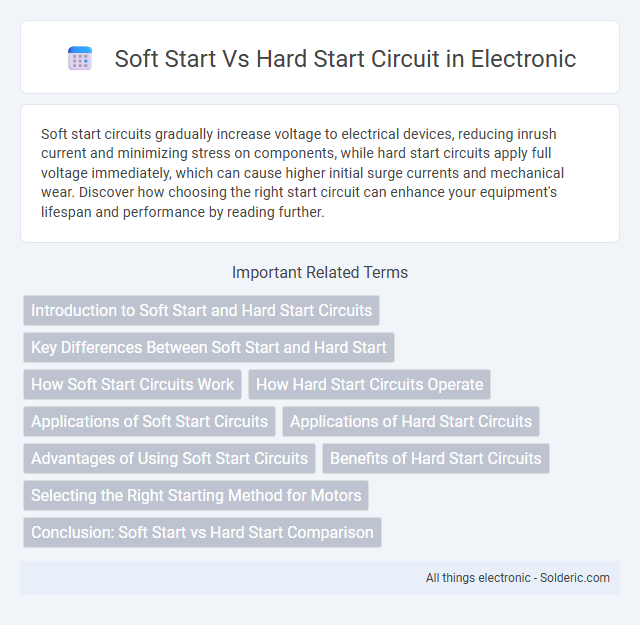Soft start circuits gradually increase voltage to electrical devices, reducing inrush current and minimizing stress on components, while hard start circuits apply full voltage immediately, which can cause higher initial surge currents and mechanical wear. Discover how choosing the right start circuit can enhance your equipment's lifespan and performance by reading further.
Comparison Table
| Feature | Soft Start Circuit | Hard Start Circuit |
|---|---|---|
| Definition | Gradually increases voltage to the motor, reducing inrush current. | Applies full voltage instantly to the motor at startup. |
| Inrush Current | Low, controlled increase. | High, sudden spike. |
| Motor Stress | Reduced mechanical and thermal stress. | Higher mechanical and thermal stress. |
| Complexity | More complex, requires additional components. | Simple design, minimal components. |
| Cost | Higher due to extra components. | Lower cost. |
| Typical Applications | Large motors, industrial machines, where current limiting is needed. | Small motors, simple devices, where startup current is not critical. |
| Protection | Provides protection to motor and electrical supply. | Limited protection against current surge. |
| Energy Efficiency | Better energy efficiency during startup. | Less efficient during startup due to current spike. |
Introduction to Soft Start and Hard Start Circuits
Soft start circuits gradually increase voltage to electrical motors, minimizing inrush current and reducing mechanical stress during startup. Hard start circuits provide an immediate full voltage application, resulting in a rapid motor startup but higher inrush current and potential wear. Understanding these differences helps you choose the appropriate starting method for your motor's longevity and performance.
Key Differences Between Soft Start and Hard Start
Soft start circuits gradually increase voltage to electrical motors, reducing inrush current and mechanical stress during startup, enhancing longevity and energy efficiency. Hard start circuits apply full voltage immediately, causing higher inrush current and potential stress on components but providing faster startup times. Key differences include controlled current ramp-up in soft start versus abrupt power application in hard start, impacting motor lifespan, energy consumption, and operational smoothness.
How Soft Start Circuits Work
Soft start circuits gradually increase the voltage and current supplied to a load, reducing inrush current and minimizing stress on electrical components. They often use components like NTC thermistors, MOSFETs, or relay-based systems controlled by a microcontroller to limit the initial surge during power-up. By controlling the ramp-up time, soft start circuits enhance device longevity and improve overall reliability in power supplies and motor drives.
How Hard Start Circuits Operate
Hard start circuits operate by providing an initial high-voltage boost to the compressor during startup, reducing the amperage draw and preventing motor overload. These circuits typically include a start capacitor and a potential relay to temporarily increase starting torque. Your HVAC system benefits from improved compressor efficiency and extended motor lifespan due to smoother startup with hard start circuits.
Applications of Soft Start Circuits
Soft start circuits are widely used in applications requiring controlled power-up sequences, such as in power supplies, motor drives, and LED lighting systems to prevent inrush current and reduce stress on components. Your electronic devices benefit from soft start circuits by ensuring smooth voltage ramp-up, enhancing system reliability, and prolonging the lifespan of sensitive components. These circuits are crucial in industrial automation and consumer electronics where minimizing electrical noise and surges during startup is essential.
Applications of Hard Start Circuits
Hard start circuits are commonly applied in air conditioning compressors, refrigeration systems, and HVAC units to provide an initial boost of torque during motor startup, preventing motor stalls and reducing wear on components. These circuits are essential for heavy-duty motors that experience frequent start-stop cycles or high starting loads, ensuring reliable operation and extending equipment lifespan. Your industrial or commercial cooling systems benefit significantly from hard start circuits by improving startup efficiency and minimizing electrical stress.
Advantages of Using Soft Start Circuits
Soft start circuits reduce inrush current and mechanical stress on electrical components, prolonging the lifespan of motors and power supplies. They provide smoother voltage ramp-up, minimizing electrical noise and preventing sudden power surges that can damage sensitive electronics. Using a soft start circuit improves overall system reliability and efficiency by controlling startup current in a controlled manner.
Benefits of Hard Start Circuits
Hard start circuits provide improved motor starting performance by delivering a high starting torque, reducing the strain on the compressor during startup. They enhance the reliability and longevity of HVAC systems by minimizing voltage drops and preventing frequent motor resets caused by locked rotor conditions. Your equipment benefits from faster startup times and increased efficiency, particularly in applications with high starting load demands.
Selecting the Right Starting Method for Motors
Choosing between a soft start and hard start circuit depends on your motor's operational requirements and the load characteristics. Soft start circuits gradually increase voltage to reduce inrush current, minimizing mechanical stress and extending motor lifespan, making them ideal for high inertia loads. Hard start circuits provide a sudden voltage surge, suitable for applications needing immediate full torque, but they may cause higher electrical stress and wear on the motor components.
Conclusion: Soft Start vs Hard Start Comparison
Soft start circuits gradually increase voltage or current to protect motors and reduce inrush current, enhancing the lifespan of your equipment and preventing electrical stress. Hard start circuits apply full power immediately, which can cause higher mechanical and electrical strain but allow faster startup times. Choosing between soft start and hard start depends on your specific application needs for motor protection versus startup speed.
soft start vs hard start circuit Infographic

 solderic.com
solderic.com